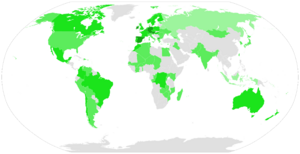Green party facts for kids
A green party is a type of political party that focuses on protecting the environment. These parties also work on other important issues like social justice, which means making sure everyone in society is treated fairly.
Green parties often share ideas with social democratic parties about how the economy should work. They frequently team up with other left-wing parties to form governments.
You can find Green parties in almost 90 countries. Many of them belong to a worldwide group called the Global Greens.
Contents
What Do Green Parties Believe In?
There's a difference between being a "green" politician and being part of a "Green" party. Any politician can be called "green" if they care about the environment.
However, official Green parties have a whole set of beliefs, or an ideology. Besides protecting the planet, they also focus on things like social justice and making decisions where everyone agrees.
The Global Greens Charter lists six main ideas that guide Green parties:
- Ecological wisdom: Understanding and protecting nature.
- Social justice: Fighting for fairness and equality for all people.
- Participatory democracy: Giving people more say in decisions that affect their lives.
- Nonviolence: Solving problems peacefully.
- Sustainability: Using resources wisely so they last for future generations.
- Respect for diversity: Valuing people from all different backgrounds.
History of Green Parties

Parties focused on the environment started appearing in the early 1970s.
The first parties of this kind were the United Tasmania Group in Australia and the Values Party in New Zealand, both in 1972. In Europe, the first national green party was PEOPLE, founded in Great Britain in 1973. This party later became the Green Party.
The German Green Party became famous in the 1980s. They were well-known for being against nuclear power and for supporting peace. They joined the German federal government in 1998. This was a big step for Green parties everywhere.
In 1995, the Finnish Green Party became the first Green party in Europe to be part of a national government. Since then, Green parties in countries like Belgium, France, and Ireland have also been in government.
Today, Green parties exist in most democratic countries, from Canada to South Africa. They have representatives at local, regional, and national levels all over the world.
Who Supports Green Parties?
Studies show that people who vote for Green parties often have things in common. Green voters are often young, have a high level of education, and work in jobs like healthcare, teaching, or the arts.
They tend to care a lot about the environment and believe in liberal social values. Support for Green parties is often higher in countries with strong economies.
Working with Other Parties
Because Green parties don't always win enough votes to govern alone, they often form teams, or alliances, with other parties.
A common type of team is a Red-Green alliance. This is when a Green party works with a social democratic party. They do this to win elections or to form a government together after an election.
Sometimes, Greens team up with different groups. For example, they might work with indigenous peoples to protect traditional lands and resources. These alliances show how Greens try to work with many different kinds of people to achieve their goals.
Green Parties Around the World
Europe

Europe has a strong Green movement. The first Green parties started here in the 1970s. After years of working together, they formed the European Green Party, which unites most Green parties on the continent.
In the European Parliament, the Greens are an important group. They work with an alliance of parties representing "stateless nations," like Wales and Scotland.
Some of the most successful Green parties are in Europe.
- Germany: Alliance '90/The Greens is one of the most influential Green parties. They were part of Germany's national government from 1998 to 2005 and joined the government again in 2021.
- Latvia: In 2004, Latvia became the first country in the world to have a Green politician, Indulis Emsis, as its head of government.
- United Kingdom: In 2010, Caroline Lucas became the first Green Party member elected to the UK's House of Commons. In 2024, the party won a record four seats.
- Ireland: The Irish Green Party has been part of coalition governments several times, most recently starting in 2020.
Asia and Oceania
Green parties have also had success in the Asia-Pacific region.
- Australia: The Australian Greens have seats in the national parliament, especially in the Australian Senate. They also have representatives in many state parliaments.
- New Zealand: The Green Party of Aotearoa New Zealand is a major political force. After the 2023 election, it held 15 seats in parliament. The party was part of the government from 2017 to 2023.
- Lebanon: The Green Party of Lebanon was founded in 2008. In 2011, it became the first political party in Lebanon to elect a woman as its leader.
North America
- Canada: The Green Party of Canada won its first seat in the national parliament in 2011, when its leader Elizabeth May was elected. As of 2025, the party holds two seats. Provincial Green parties have also had success, especially in British Columbia, Prince Edward Island, and New Brunswick.
- United States: The Green Party of the United States has not won any seats in the U.S. Congress. However, hundreds of Greens have been elected to local offices, such as city councils and school boards, across the country. The party has run candidates in several presidential elections.
- Mexico: The Ecologist Green Party has members in Mexico's Congress. However, its policies on some issues have caused the European Green Party to no longer recognize it as a true Green party.
South America
- Brazil: The Brazilian Green Party was founded after the country's military dictatorship ended. In the 2010 presidential election, their candidate, Marina Silva, won over 19% of the vote.
- Colombia: The Colombian Green Party was formed for the 2010 presidential election. Its leader, former Bogotá mayor Antanas Mockus, was a popular candidate.
Green Parties in Government
While many Green parties are small, some have joined national governments, usually as a partner in a coalition. The table below shows some of the times Green parties have been part of a national government.
| Country | Party | Years in government | Coalition partner/s | |
|---|---|---|---|---|
| Green League | 1995–2002 | Social Democratic Party of Finland National Coalition Party Swedish People's Party of Finland Left Alliance |
||
| 2007–2011 | Centre Party National Coalition Party Swedish People's Party of Finland |
|||
| 2011–2014 | National Coalition Party Social Democratic Party of Finland Left Alliance Swedish People's Party of Finland Christian Democrats |
|||
| 2019–2023 | Social Democratic Party of Finland Centre Party Left Alliance Swedish People's Party of Finland |
|||
| The Greens | 1997–2002 | Socialist Party French Communist Party Radical Party of the Left Citizen and Republican Movement |
||
| Europe Ecology – The Greens | 2012–2014 | Socialist Party Radical Party of the Left Walwari |
||
| Ecologist Party | 2016–2017 | Socialist Party Radical Party of the Left |
||
| Alliance 90/The Greens | 1998–2005 | Social Democratic Party of Germany | ||
| 2021–2024 | Social Democratic Party of Germany Free Democratic Party |
|||
| 2024–2025 | Social Democratic Party of Germany | |||
| Ecolo | 1999–2003 | Open Flemish Liberals and Democrats Liberal Reformist Party Socialist Party Flemish Socialist Party |
||
| Agalev | ||||
| Ecolo | 2020–2025 | Open Flemish Liberals and Democrats Reformist Movement Vooruit Socialist Party Christian Democratic and Flemish |
||
| Groen | ||||
| Green Party | 2007–2011 | Fianna Fáil Progressive Democrats |
||
| 2020–2025 | Fianna Fáil Fine Gael |
|||
| Green Party | 2007–2009 | Civic Democratic Party KDU-ČSL |
||
| Left-Green Movement | 2009–2013 | Social Democratic Alliance | ||
| 2017–2024 | Independence Party Progressive Party |
|||
| The Greens | 2013–2023 | Democratic Party Luxembourg Socialist Workers' Party |
||
| Green Party (Sweden) | 2014–2021 | Swedish Social Democratic Party | ||
| Green Party of Aotearoa New Zealand | 2017–2020 | New Zealand Labour Party New Zealand First |
||
| 2020–2023 | New Zealand Labour Party | |||
| The Greens – The Green Alternative | 2020–2025 | Austrian People's Party | ||
| United Reform Action | 2020–2022 | Ne damo Crnu Goru | ||
| 2022–2023 | Socialist People's Party of Montenegro Social Democratic Party of Montenegro Bosniak Party |
|||
Images for kids
-
British MP Caroline Lucas was the UK's first green politician elected under the first-past-the-post system.
See also
- Green and chartreuse – colors associated with the Green movement
- List of green political parties
- Outline of green politics





